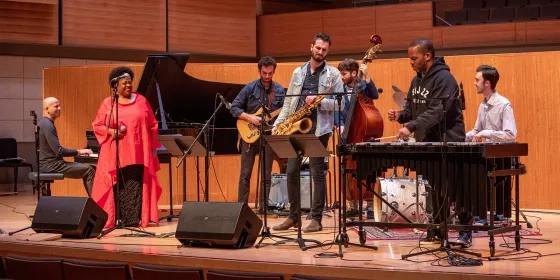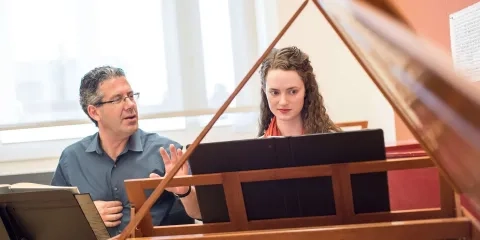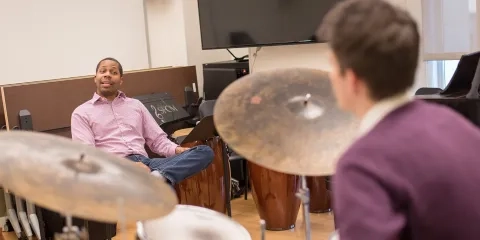First-Ever SFCM Class Merges Jazz with Baroque
In a first-of-its-kind offering, SFCM faculty Jason Hainsworth and Corey Jamason teach improvisation from both a jazz and baroque viewpoint.
By Alex Heigl
One doesn’t typically think of the harpsichord as an especially swinging instrument, but Corey Jamason and Jason Hainsworth are here to change that.
Jamason, SFCM's Historical Performance Chair, and Hainsworth, Executive Director of Roots, Jazz and American Music, are teaming up to offer SFCM students a brand-new class that will focus on improvisation in the seemingly disparate realms of jazz and baroque music. And the class promises another SFCM first: An ensemble combining traditional jazz instruments like saxophones with baroque standbys like the harpsichord. The module launched in the third week of March and hopefully will return to the curriculum after this semester. April is Jazz Appreciation Month in the United States.
"One of the lovely things about this school is a desire to break down ideas about what's supposed to be here and what's supposed to be there and bring them together,” Jamason said. “Music is music and musicians can learn a lot from each other, especially about the act of improvisation, which is fundamental to who we are—our true voice.”
“There’s a need for collaboration within the school, but there’s also a need to demystify some of these walls that we naturally put up between jazz musicians and classical musicians,” Hainsworth said. “But we were still coming from the basis of, ‘What would be a fun course that we would want to take if we were studying here?'”
“For years, ever since I started working here, Corey and I would just, at faculty meetings or in the halls, talk about how you'd teach students baroque improvisation,” he continued. “How you'd teach them how to use the very traditional instruments or figured bass—the typical things that baroque musicians would use to create music in real-time.”
“We talk nowadays about how we recreate a score,” Jamason said. “And that's fine and that's good and I'm sure the baroque composers would like that, but they expected and wrote in a way to allow room for performers to improvise.”
The overlap between baroque music and jazz might not be apparent to contemporary listeners, but it is substantial. Baroque soloists on any instrument were expected to add ornamentations of their choosing to the melody they were playing, much like a horn player reinterpreting a jazz standard. And there was the practice of basso continuo, in which composers would notate bass parts and expect a harmony instrument (like the harpsichord) to devise its part extemporaneously from there, which Jamason says is “very similar to what a jazz pianist would do.” He added that Bach even faced criticism in his time for notating his parts too strictly and not leaving room for the musicians to showcase their individuality.
Musicians from the era even swung their eighth notes: “French baroque music, if they were playing in stepwise motion at a moderate or slowish tempo, [the rhythm] would often be very similar to swing music,” Jamason said, a quality called “inégales.” “Musicians from both those areas were and are expected to know where they were in a key or tonal center and what notes work, what notes don’t work, or what notes lead to where,” Hainsworth said. “There are also similarities in terms of standard material that jazz musicians know and baroque musicians knew back then,” he continued. “You could gather musicians together and call a tune and they’d all be expected to know how to play it.”
"We read about the improvisers from the baroque era, how incredible they were, and it seems distant,” Jamason added. “Because improvisation is kind of less of a thing in classical music nowadays,” he continued, classical musicians can look to jazz players to help close that distance.
“There's no such thing as a wrong improvisation: If it's something from somebody's heart, then it's true,” Jamason added.
Learn more about studying historical performance or RJAM at SFCM.


